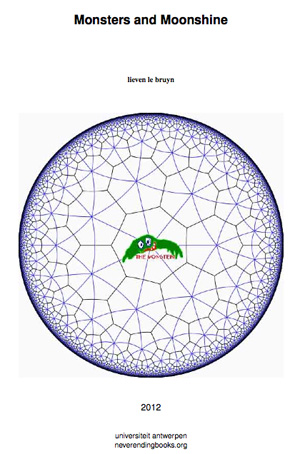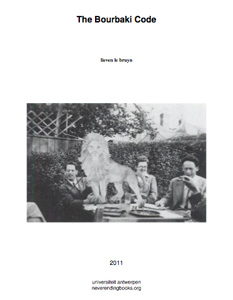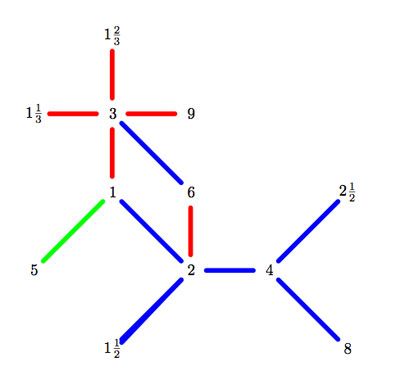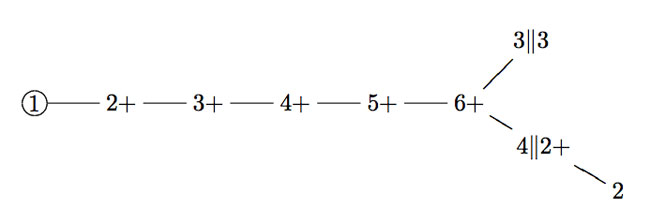Today, Samuel Dehority, Xavier Gonzalez, Neekon Vafa and Roger Van Peski arXived their paper Moonshine for all finite groups.
Originally, Moonshine was thought to be connected to the Monster group. McKay and Thompson observed that the first coefficients of the normalized elliptic modular invariant
\[
J(\tau) = q^{-1} + 196884 q + 21493760 q^2 + 864229970 q^3 + \ldots
\]
could be written as sums of dimensions of the first few irreducible representations of the monster group:
\[
1=1,~\quad 196884=196883+1,~\quad 21493760=1+196883+21296876,~\quad … \]
Soon it transpired that there ought to be an infinite dimensional graded vectorspace, the moonshine module
\[
V^{\sharp} = \bigoplus_{n=-1}^{\infty}~V^{\sharp}_n \]
with every component $V^{\sharp}_n$ being a representation of the monster group $\mathbb{M}$ of which the dimension coincides with the coefficient of $q^n$ in $J(\tau)$.
It only got better, for any conjugacy class $[ g ]$ of the monster, if you took the character series
\[
T_g(\tau) = \sum_{n=-1}^{\infty} Tr(g | V^{\sharp}_n) q^n \]
you get a function invariant under the action of the subgroup
\[
\Gamma_0(n) = \{ \begin{bmatrix} a & b \\ c & d \end{bmatrix}~:~c = 0~mod~n \} \]
acting via transformations $\tau \mapsto \frac{a \tau + b}{c \tau + d}$ on the upper half plane where $n$ is the order of $g$ (or, for the experts, almost).
Soon, further instances of ‘moonshine’ were discovered for other simple groups, the unifying feature being that one associates to a group $G$ a graded representation $V$ such that the character series of this representation for an element $g \in G$ is an invariant modular function with respect to the subgroup $\Gamma_0(n)$ of the modular group, with $n$ being the order of $g$.
Today, this group of people proved that there is ‘moonshine’ for any finite group whatsoever.
They changed the definition of moonshine slightly to introduce the notion of moonshine of depth $d$ which meant that they want the dimension sequence of their graded module to be equal to $J(\tau)$ under the action of the normalized $d$-th Hecke operator, which means equal to
\[
\sum_{ac=d,0 \leq b < c} J(\frac{a \tau + b}{c}) \]
as they are interested in the asymptotic behaviour of the components $V_n$ with respect to the regular representation of $G$.
What baffled me was their much weaker observation (remark 2) saying that you get ‘moonshine’ in the form described above, that is, a graded representation $V$ such that for every $g \in G$ you get a character series which is invariant under $\Gamma_0(n)$ with $n=ord(g)$ (and no smaller divisor of $n$), for every finite group $G$.
And, more importantly, you can explain this to any student taking a first course in group theory as all you need is Cayley’s theorem stating that any finite group is a subgroup of some symmetric group $S_n$.
Here’s the idea: take the original monster-moonshine module $V^{\sharp}$ but forget all about the action of $\mathbb{M}$ (that is, consider it as a plain vectorspace) and consider the graded representation
\[
V = (V^{\sharp})^{\otimes n} \]
with the natural action of $S_n$ on the tensor product.
Now, embed a la Cayley $G$ into $S_n$ then you know that the order of $g \in G$ is the least common multiple of the cycle lengths of the permutation it it send to. Now, it is fairly trivial to see that the character series of $V$ with respect to $g$ (having cycle lengths $(k_1,k_2,\dots,k_l)$, including cycles of length one) is equal to the product
\[
J(k_1 \tau) J(k_2 \tau) \dots J(k_l \tau) \]
which is invariant under $\Gamma_0(n)$ with $n = lcm(k_i)$ (but no $\Gamma_0(m)$ with $m$ a proper divisor of $n$).
For example, for $G=S_4$ we have as character series of $(V^{\sharp})^{\otimes 4}$
\[
(1)(2)(3)(4) \mapsto J(\tau)^4 \]
\[
(12)(3)(4) \mapsto J(2 \tau) J(\tau)^2 \]
\[
(12)(34) \mapsto J(2 \tau)^2 \]
\[
(123)(4) \mapsto J(3 \tau) J(\tau) \]
\[
(1234) \mapsto J(4 \tau) \]
Clearly, the main results of the paper are much more subtle, but I’m already happy with this version of ‘moonshine for everyone’!
Leave a Comment


 Time to wrap up this series on
Time to wrap up this series on  They can be described using the mini-moonshine picture on the right. They are :
They can be described using the mini-moonshine picture on the right. They are :
